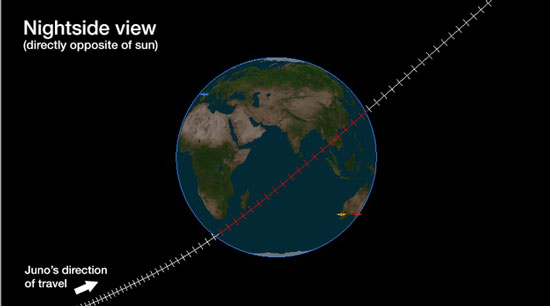| Oct 09, 2013 |
ESA and NASA stumped by cosmic mystery
|
|
(Nanowerk News) A mystery that has stumped scientists for decades might be one step closer to solution after ESA tracking stations carefully record signals from NASA’s Juno spacecraft as it swings by Earth today.
|
|
NASA’s deep-space probe will zip past to within 561 km at 19:21 GMT as it picks up a gravitational speed boost to help it reach Jupiter in 2016.
|
|
During the high-speed event, radio signals from the 3225 kg Juno will be carefully recorded by ESA tracking stations in Argentina and Australia.
|
 |
| The Earth gravity assist is required to accelerate Juno’s arrival at Jupiter on 4 July 2016 and will capture an unprecedented movie of the Earth–Moon system. (Credit: NASA/JPL)
|
|
Engineers hope that the new measurements will unravel the decades-old ‘flyby anomaly’ – an unexplained variation in spacecraft speeds detected during some swingbys.
|
|
“We detected the flyby anomaly during Rosetta’s first Earth visit in March 2005,” says Trevor Morley, flight dynamics expert at ESA’s ESOC operations centre in Darmstadt, Germany.
|
|
“Frustratingly, no anomaly was seen during Rosetta's subsequent Earth flybys in 2007 and 2011. This is a real cosmic mystery that no one has yet figured out.”
|
|
Sometimes there, sometimes not
|
|
Since 1990, mission controllers at ESA and NASA have noticed that their spacecraft sometimes experience a strange variation in the amount of orbital energy they pick up from Earth during flybys, a technique routinely used to fling satellites deep into our Solar System.
|
|
The unexplained variation is noticed as a tiny difference in the expected speed gained (or lost) during the passage.
|
|
The variations are extremely small: NASA’s Jupiter probe ended up just 3.9 mm/s faster than expected when it swung past Earth in December 1990.
|
|
The largest variation– a boost of 13.0 mm/s – was seen with NASA’s NEAR asteroid craft in January 1998. Conversely, the differences during swingbys of NASA’s Cassini in 1999 and Messenger in 2005 were so small that they could not be confirmed.
|
|
The experts are stumped.
|
|
|
|
Juno spacecraft Earth flyby animation
|
|
ESA stations listen for Juno
|
|
On 9 October, engineers and the flight dynamics teams at ESOC will watch closely as the Agency’s new 35 m-diameter deep-space dish in Malargüe, Argentina, and a smaller 15 m dish in Perth, Australia, track Juno starting at about 16:00 GMT.
ESA's 35m Malargüe deep-space tracking station, Argentina, is part of the Estrack network
|
|
The stations will record highly precise radio-signal information that will indicate whether Juno speeds up or slows down more or less than predicted by current theories.
|
|
The results will be studied closely by ESA and NASA as well as scientists worldwide, who are hoping to see whether the anomaly is again detected.
|
|
“Our Malargüe station is designed to track very distant and relatively slow-moving spacecraft, while Juno will pass by moving very, very fast at just 561 km altitude,” says ESA’s Daniel Firre, responsible for the tracking support at ESOC.
|
|
“This makes tracking Juno technically very challenging, but it’s how the scientific process works. Gathering more data that can be analysed by experts is critical if we are ever to solve this perplexing mystery.”
|

